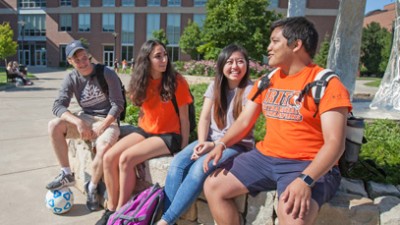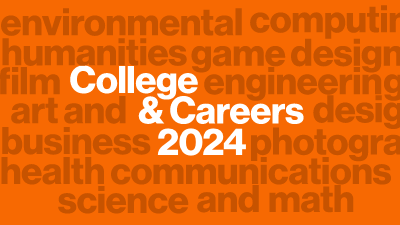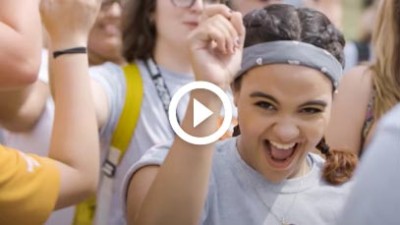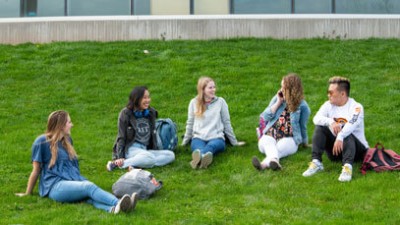Ceramics Option - Studio Arts BFA - Curriculum
Ceramics Option - Studio Arts BFA
Studio Arts (ceramics option), BFA degree, typical course sequence
| Course | Sem. Cr. Hrs. | |
|---|---|---|
| First Year | ||
| ARTH-1## | General Education – Artistic Perspective: Any 100-level ARTH Course |
3 |
| ARTH-1## | General Education – Global Perspective: Any 100-level ARTH Course |
3 |
| FDTN-111 | Drawing I This course is an introduction to the visualization of form, thought, and expression through the drawing process and is the first of two sequential courses that are the foundation of the drawing curriculum in the College of Art and Design. Concepts are introduced by lectures, discussions, and demonstrations which are designed to provide a broad introductory experience. Students will experiment with a wide variety of media, tools, techniques and subjects to develop drawing and problem-solving skills related to form and composition. The focus of the course is to provide awareness of the full range of ways in which drawing is used as a tool for both self-expression and communication. **Fee: A materials fee is required for this course, and an additional course fee applied via student account** Studio 6 (Fall or Spring). |
3 |
| FDTN-121 | 2D Design I This course is an introduction to the basic elements and principles of two-dimensional design and is foundational to the College of Art and Design curriculum. The focus of this course is the development of visual and verbal vocabularies as a means of exploring and understanding two-dimensional design. Students will engage with a wide variety of media, tools, and techniques to develop skills while delving into the theoretical and experimentational processes of contemporary art and design. The exploration of historical and cultural themes and concepts intertwined with aspects of personal interpretation and experience will be included in the curriculum. **Fee: A materials fee is required for this course, and an additional course fee applied via student account** Studio 6 (Fall or Spring). |
3 |
| FDTN-131 | 3D Design I This course presents a progressive study in terminology, visual principles, exploration, concept generation, process, and techniques of three-dimensional design and is foundational to the College of Art and Design curriculum. Using hands-on problem solving, student will develop an informed understanding of the three-dimensional form and space with an emphasis on the elements and principles of visual design and their function as the building blocks and guidelines for ordering a three-dimensional composition. A heightened awareness of form and space will be developed through lecture, assigned projects, and critiques. Students will also develop a personal awareness of problem seeking and solving, experimentation and critical analysis. **Fee: A materials fee is required for this course, and an additional course fee applied via student account** Studio 6 (Fall or Spring). |
3 |
| Choose one of the following: | 3 |
|
| FDTN-112 | Drawing II From observation of still life, the figure, and interior/exterior spaces, Drawing II continues to build on the foundation of the College of Art and Design drawing curriculum. This course continues the study of traditional drawing mediums and techniques while introducing color and a selection of contemporary practices and tools through examining organic and geometric mark making, form, space and value. Core concepts are introduced by lectures, discussions, and demonstrations; the primary assessment method of course work will be through critiques which facilitate growth of both a visual and verbal vocabulary. The focus of the course is to provide awareness of the full range of ways in which drawing is used as a tool for self-expression, communication and continued development of creative practice and problem solving. **Fee: A materials fee is required for this course, and an additional course fee applied via student account** (Prerequisites: FDTN-111 or ITDI-211 or equivalent course.) Studio 6 (Fall or Spring). |
|
| FDTN-212 | Drawing II Workshop: Topics This course is an investigation of the visualization of form, thought and expression through the drawing process. This workshop provides students with the opportunity to learn more about a particular experience in drawing while still covering required foundation elements. Different topics may be taken in the same semester. Topics may only be taken once. Concepts are introduced by lectures, discussions, demonstrations, research and assigned projects.. The focus of the course is to provide awareness of the full range of ways in which drawing is used as a tool for both self-expression and communication. (Prerequisites: FDTN-111 or ITDI-211 or equivalent course.) Studio 6 (Spring). |
|
| Choose one of the following: | 3 |
|
| FDTN-132 | 3D Design II This course is the second course in the three-dimensional design curriculum and is foundational to the College of Art and Design education. The focus of the course is on composing three-dimensional form and its relationship to space. Students will build on their prior term experiences, which include the introduction to three-dimensional principles, materials, and building processes. Students will develop the sophisticated skill of conceptualization. More advanced problems will be assigned, and students will have the opportunity to explore a wide range of material and process possibilities for their resolution. A heightened awareness of idea development and design research will be explored. Inclusion of 21st century themes in the arts of social cultural and community. **Fee: A materials fee is required for this course, and an additional course fee applied via student account** (Prerequisites: FDTN-131 or equivalent course.) Studio 6 (Fall or Spring). |
|
| FDTN-232 | 3D Design II Workshop: Topic This workshop provides students with the opportunity to learn more about 3D compositions within a more open and experimental realm while still covering the core Foundation concepts. Different topics may be taken in the same semester. Topics may only be taken once. The focus is on composing three-dimensional form and its
relationship to space. Material exposure will be determined by the topic’s instructor. (Prerequisites: FDTN-131 or equivalent course.) Studio 6 (Spring). |
|
| YOPS-10 | RIT 365: RIT Connections RIT 365 students participate in experiential learning opportunities designed to launch them into their career at RIT, support them in making multiple and varied connections across the university, and immerse them in processes of competency development. Students will plan for and reflect on their first-year experiences, receive feedback, and develop a personal plan for future action in order to develop foundational self-awareness and recognize broad-based professional competencies. (This class is restricted to incoming 1st year or global campus students.) Lecture 1 (Fall, Spring). |
0 |
CAD Studio Elective |
3 | |
General Education – First-Year Writing (WI) |
3 | |
General Education – Social Perspective |
3 | |
| Second Year | ||
| CCER-206 | Ceramic Sculptural Processes This introductory course is designed to give the student an understanding of a variety of basic processes involved in creating hand-built ceramic objects, sculpture, and pottery vessels. There will be an emphasis on manipulating clay using forming techniques such as pinch, coil, solid, and slab building. Students will learn surface finishing processes such as textures and surface carving and decorating with slips, glaze applications, and gain a perspective on material science. The historical, cultural, and technical concerns of ceramics will be explored. These experiences will broaden the students' perspectives of ceramic art and its relationship to the larger world of art. **Fee: A materials fee is required for this course, and an additional course fee applied via student account** (Prerequisites: FDTN-111 or CCER-124 or CCER-128 or equivalent course.) Studio 6 (Fall). |
3 |
| CCER-211 | Thrown Vessel Forms This course will introduce the student to beginning wheel forming techniques used in the ideation and creation of utilitarian vessels. There will be a focus on form, function and surface development. Students will engage in a variety finishing processes for surface development as well as slip and glaze application. Students will gain an understanding of a variety of firing techniques, as well as an introduction to material science to better understand the properties clay and glaze composition. The historical, cultural, and technical concerns of ceramics will be explored. These experiences will broaden the students' perspectives of ceramic art and its relationship to the larger world of art. Students will be expected to research areas of interest within ceramic history.**Fee: A materials fee is required for this course, and an additional course fee applied via student account** (Prerequisites: FDTN-111 or CCER-124 or CCER-128 or equivalent course.) Studio 6 (Fall or Spring). |
3 |
| CCER-513 | Thrown Sculptural Forms This course will introduce students to intermediate forming techniques used in the ideation and creation of both utilitarian and sculptural vessels. There will be a focus on form, surface development, and aesthetics. The student will gain experience with firing methodologies. The students will also work with material science to better understand clay and glaze chemistry. The historical, cultural, and technical concerns of ceramics will be explored. These experiences will broaden the students' perspectives of ceramic art and its relationship to the larger world of art. Students will be expected to research areas of interest within ceramic history or the field at large. This course will introduce students to the skills that are necessary for creating a variety of forms through assigned projects. **Fee: A materials fee is required for this course, and an additional course fee applied via student account** (Prerequisites: FDTN-111 or CCER-124 or CCER-128 or equivalent course.) Studio 6 (Fall or Spring). |
3 |
| CCER-507 | Mold Mechanisms This course will concentrate on the fundamentals of plasterwork, mold-making, and slip-casting. Students will first engage in a series of directed exercises to build proficiency, and then apply what they’ve learned to the production of complex mold systems. By way of experimentation, students will broaden conceptualization of positive and negative spatial relationships while developing problem solving capacity. Supporting information relating to historical, cultural, and scientific concerns will be provided to broaden the students' perspectives of ceramic art, design, and industry, as well as its relationship to the larger world of art. **Fee: A materials fee is required for this course, and an additional course fee applied via student account** (Prerequisites: CCER-124 or CCER-128 or FDTN-131 or SCUL-201 or SCUL-269 or equivalent courses.) Studio 6 (Fall or Spring). |
3 |
| FDTN-141 | 4D Design 4D Design introduces students to the basic concepts of art and design in time and space. The course explores elements of moving images such as continuity, still and moving image editing, transitions and syntax, sound and image relations, and principles of movement. Computers, video, photo, sound and lighting equipment are used to create short-form time-based work relevant to students in all majors and programs required to take this course. The course addresses the both historical conventions of time in art and recent technological advances, which are redefining the fields of Fine Art and Design. In focusing on the relations between students' spacing and timing skills, 4D Design extends and supplements the other Foundation courses, and prepares students for further work with time-based media. (Undergraduate Art and Design) Lab 5 (Fall, Spring). |
3 |
| STAR-503 | CAD Drawing This class covers basic CAD (computer-aided design) drawing for both design and presentation. Topics covered will include a broad range of drawing types, three-dimensional modeling, and presentation techniques. The course includes demonstrations, lectures, group-discussions, projects, and presentations. At the completion of this course students will use skills obtained in CAD orthographic drawing and 3-dimensional modeling to refine and present ideas and projects. Lec/Lab 5 (Fall or Spring). |
3 |
General Education – Immersion 1 (WI-GE) |
3 | |
Art History Elective‡ |
3 | |
General Education – Ethical Perspective |
3 | |
| Choose one of the following: | 3 |
|
General Education – Natural Science Inquiry Perspective |
||
General Education – Scientific Principles Perspective |
||
General Education – Mathematical Perspective A or B |
||
| Third Year | ||
| CCER-501 | Ceramic Practice Students will continue advanced research into their technical, aesthetic and conceptual understanding of ceramics. In this course, students create a proposal which will guide their research and practice. Working with faculty to explore individual directions, students will produce finished artwork for their senior capstone exhibition. **Fee: A materials fee is required for this course, and an additional course fee applied via student account** (Co-requisite: CCER-511 or equivalent course.) Studio 6 (Fall or Spring). |
6 |
| CCER-511 | Ceramics Processes Students will build upon their experience to further advance the technical, aesthetic and conceptual understanding of ceramic form and surface. This course will work from a set of prompts which will provide parameters for building individual bodies of work in a variety of different forming processes. Students will work from conceptual and contextual prompts to gain insight and build skills with advanced forming processes, surface investigation, idea development, and documentation. **Fee: A materials fee is required for this course, and an additional course fee applied via student account** (Prerequisites: CCER-206 or CCER-211 or CCER-507 or CCER-512 or equivalent course.) Studio 6 (Fall or Spring). |
6 |
| STAR-311 | Ideation and Series This course will examine appropriate skills and strategies to generate ideas and develop them effectively. Through personal and group generative idea exercises, journaling and research students will explore individual ideas and personal interests to produce a final series of creative works. (Prerequisites: FDTN-141 or equivalent course or students enrolled in the WOOD-AOS program.) Studio 6 (Fall or Spring). |
3 |
Art History Elective‡ |
3 | |
General Education – Immersion 2 |
3 | |
CAD Studio Elective† |
3 | |
General Education – Elective |
3 | |
Open Elective |
3 | |
| Fourth Year | ||
| CCER-501 | Ceramic Practice Students will continue advanced research into their technical, aesthetic and conceptual understanding of ceramics. In this course, students create a proposal which will guide their research and practice. Working with faculty to explore individual directions, students will produce finished artwork for their senior capstone exhibition. **Fee: A materials fee is required for this course, and an additional course fee applied via student account** (Co-requisite: CCER-511 or equivalent course.) Studio 6 (Fall or Spring). |
6 |
| CCER-511 | Ceramic Processes Students will build upon their experience to further advance the technical, aesthetic and conceptual understanding of ceramic form and surface. This course will work from a set of prompts which will provide parameters for building individual bodies of work in a variety of different forming processes. Students will work from conceptual and contextual prompts to gain insight and build skills with advanced forming processes, surface investigation, idea development, and documentation. **Fee: A materials fee is required for this course, and an additional course fee applied via student account** (Prerequisites: CCER-206 or CCER-211 or CCER-507 or CCER-512 or equivalent course.) Studio 6 (Fall or Spring). |
6 |
| STAR-411 | Business Practices for Artists (WI-PR) This course is devoted to the practical business issues that artists must address, such as: building and maintaining a portfolio, pricing, engaging established and emerging marketing strategies, public relations, and the professional presence. Students will develop the skills necessary to create a sustainable post-academic studio practice. Financial organization, communication, and networking, as well as archiving, grant writing, and interfacing with exhibition opportunities will be explored through research projects, writing assignments, and group discussion. (Prerequisites: STAR-311 or equivalent course or student standing in WOOD-AOS.) Lecture 3 (Fall or Spring). |
3 |
| STAR-401 | STAR Capstone This course will focus on the production and exhibition of a representative body of artwork. Students will participate in an articulated process of making, engaging in comprehensive research that expands and supports their work, developing a rationale for the use of media and process, creating sketches and models, and the refining work through critiquing and editing. All of this will culminate in the professional presentation of oral, written, and visual work that contextualizes the students’ positions within contemporary artistic practice. Students will also be involved in every aspect of their senior shows from creating the work to installing the exhibition and preparing marketing materials. (Prerequisites: STAR-311 or equivalent course.) Studio 6 (Spring). |
3 |
CAD Studio Elective† |
3 | |
General Education – Immersion 3 |
3 | |
Open Electives |
9 | |
| Total Semester Credit Hours | 120 |
|
Please see General Education Curriculum (GE) for more information.
(WI) Refers to a writing intensive course within the major.
Please see Wellness Education Requirement for more information. Students completing bachelor's degrees are required to complete two different Wellness courses.
† CAD Studio Electives are any College of Art and Design course with a lab or studio component.
‡ Art History electives are non-studio courses searchable in SIS with the Art History attribute of ARTH, and are 200 level or above.









